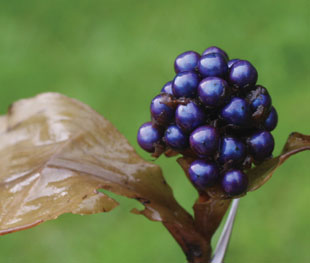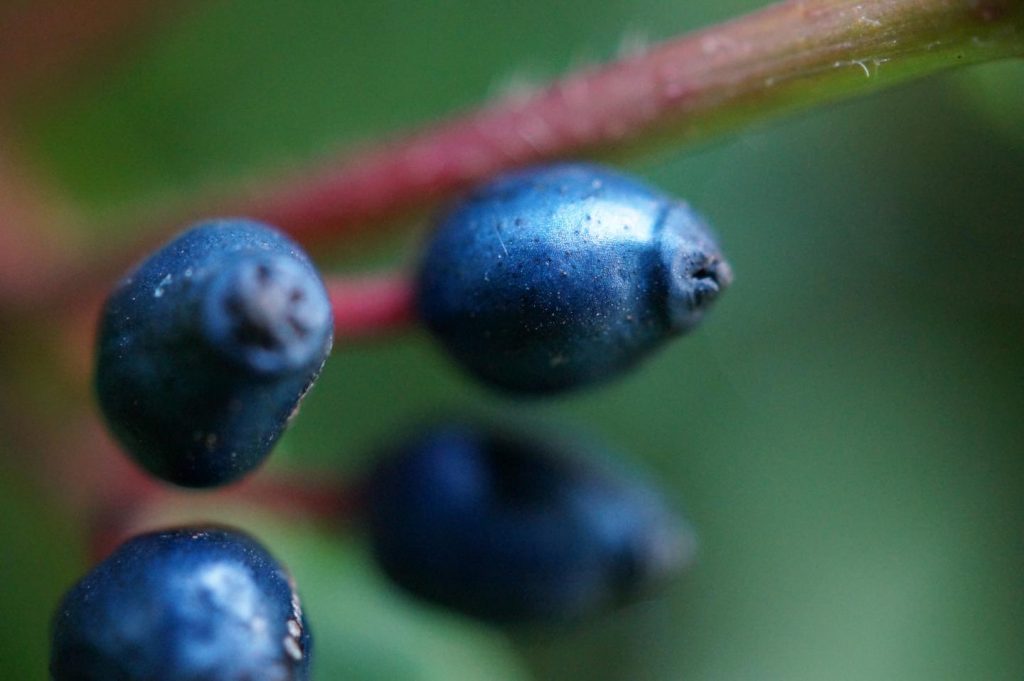I love structural colo(u) and the first such story here was this February 7, 2013 posting, which is where you’ll find the image below,

Those berries are stunning especially when you realize they are part of a long-dead Pollia plant. Scientist, Rox Middleton of University of Bristol (UK) was studying the structures that render the Pollia plant’s berries (fruit) blue when she decided to study another, more conveniently accessible plant with blue fruit. That’s when she got a surprise (from an August 11, 2020 article by Véronique Greenwood for the New York Times),
Big, leafy viburnum bushes have lined yards in the United States and Europe for decades — their domes of blossoms have an understated attractiveness. But once the flowers of the Viburnum tinus plant fade, the shrub makes something unusual: shiny, brilliantly blue fruit.
Scientists had noticed that pigments related to those in blueberries exist in viburnum fruit, and assumed that this must be the source of their odd hue. Blue fruit, after all, is rare. But researchers reported last week in Current Biology that viburnum’s blue is actually created by layers of molecules arranged under the surface of the skin, a form of what scientists call structural color. By means still unknown, the plant’s cells create thin slabs of fat [emphasis mine] arranged in a stack, like the flakes of puff pastry, and their peculiar gleam is the result.
Rox Middleton, a researcher at University of Bristol in England and an author of the new paper, had been studying the African pollia plant, which produces its own exotic blue fruit. But viburnum fruit were everywhere, and she realized that their blue had not been well-studied. Along with Miranda Sinnott-Armstrong, a researcher at the University of Colorado, Boulder, and other colleagues, she set out to take a closer look at the fruit’s skin.
The pollia fruit’s blue is a form of structural color, in which light bounces off a regularly spaced arrangement of tiny structures such that certain wavelengths, usually those that look blue or green to us, are reflected back at the viewer. In pollia fruit, the color comes from light interacting with thin sheets of cellulose packed together. At first the team thought there would be something similar in viburnum. But they saw no cellulose stacks.
…
The research team has concluded that all it comes down the arrangement of fat molecules, which are also responsible for the cloudier, metallic blue in viburnum berries,

I encourage you to read Greenwood’s August 11, 2020 article in its entirety. For those who like more details, there are two press releases. The first is an August 6, 2020 University of Cambridge press release on EurekAlert. Middleton completed the ‘Virbunum’ research while completing her PhD at Cambridge. As mentioned earlier, Middleton is currently a researcher at the University of Bristol and they issued an August 11, 2020 press release touting her accomplishment.
Finally, for the insatiably curious, here’s a link to and a citation for the paper,
Viburnum tinus Fruits Use Lipids to Produce Metallic Blue Structural Color by Rox Middleton, Miranda Sinnott-Armstrong, Yu Ogawa, Gianni Jacucci, Edwige Moyroud, Paula J. Rudall, Chrissie Prychid, Maria Conejero, Beverley J. Glover, Michael J. Donoghue, Silvia Vignolini. Current Biology DOI:https://doi.org/10.1016/j.cub.2020.07.005 Published:August 06, 2020
This paper is behind a paywall.
![AGELESS BRILLIANCE: Although the pigment-derived leaf color of this decades-old specimen of the African perennial Pollia condensata has faded, the fruit still maintains its intense metallic-blue iridescence.COURTESY OF P.J. RUDALL [downloaded from http://www.the-scientist.com/?articles.view/articleNo/34200/title/Color-from-Structure/]](http://www.frogheart.ca/wp-content/uploads/2014/06/AgelessColour_-Pollia_condensata_Herbarium2.jpg)